theartsdesk at the Ravenna Festival 2025 - Cervantes, Beethoven and Byron transfigured | reviews, news & interviews
theartsdesk at the Ravenna Festival 2025 - Cervantes, Beethoven and Byron transfigured
theartsdesk at the Ravenna Festival 2025 - Cervantes, Beethoven and Byron transfigured
Muti revitalised by young musicians, and a three-year theatre project reaches completion
Anyone seeking local genius in an international festival should look no further than the annual Ravenna concerts from Riccardo Muti – Neapolitan by birth, Ravennate by adoption – with his Luigi Cherubini Youth Orchestra. Well, maybe a little further if you have basic Italian: 2025 sees the completion of a second walkabout theatre trilogy involving citizens of Ravenna and beyond, masterminded by two greats equal to Muti in their own unique ways, Ermanna Montanari and Marco Martinelli.
The first, spellbinding adventure, a Dante triptych, I discovered in its second year, a reinvention of Purgatorio leading us from the poet's tomb to other public spaces; it reached its final goal, Paradiso, six years after the start of the project (would that I'd caught Inferno), following lockdown and other trials, but with what transcendence as we lay on the ground in front of the exquisite Loggetta Lombardesco and looked at the stars during the final lines. Don Quichotte ad ardere (Don Quixote On Fire) has made a shorter, three-year, journey, but a no less inventive one. 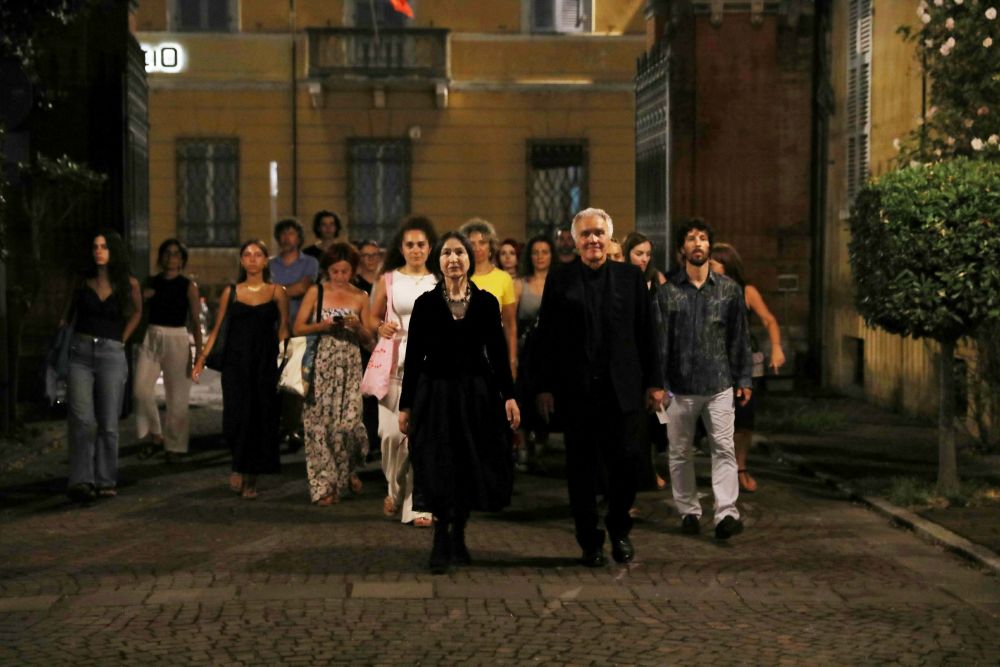 When in 2023 Montanari and Martinelli (pictured above by Silvia Lelli guiding the audience to their theatre for Part Three) worked with a vast team of professionals,students and amateurs, themselves rising this time to professional level when speaking, in the "enchanted castle" and garden of their second home, Palazzo Malagolo, over the road from their converted-church theatre, they didn't know where the journey would lead them. As they told me, "we too were 'knights errant' in creating this fresco. Like Don Quixote we relied on the dimension of the journey, and the journey lasted three years, and now it has ended. And, looking at it from the outside - as far as it’s possible for us - it seems to us that everything was 'inside' the initial seed, inside the choice to reread Cervantes' novel starting from a transfigured autobiographical key: Hermanita and Marcus, the two magicians."
When in 2023 Montanari and Martinelli (pictured above by Silvia Lelli guiding the audience to their theatre for Part Three) worked with a vast team of professionals,students and amateurs, themselves rising this time to professional level when speaking, in the "enchanted castle" and garden of their second home, Palazzo Malagolo, over the road from their converted-church theatre, they didn't know where the journey would lead them. As they told me, "we too were 'knights errant' in creating this fresco. Like Don Quixote we relied on the dimension of the journey, and the journey lasted three years, and now it has ended. And, looking at it from the outside - as far as it’s possible for us - it seems to us that everything was 'inside' the initial seed, inside the choice to reread Cervantes' novel starting from a transfigured autobiographical key: Hermanita and Marcus, the two magicians."
"Marcus" asks us, in the ruins of the so-called "Palace of Diocletian" in Part Two "I pray the Wanderers [the audience], if they have to review the show, don't drag in poor old worn-out Alice from her Wonderland, or worse, the magnificent movies of David Lynch". But Bergman and Pirandello do need a mention, if only as cues for the worlds-within-world, the play of reality and fantasy. Hermanita and Marcus, our spirit-guides, are and aren't Montanari and Martinelli; we believe in their various transformations just as we believe in the often playful interchanges of Don Quixote, Sancho Panza and a Dulcinea who here has a very strong voice with Roberto del Castillo, Aleandro Argnàn de Puerto Foras and Laura Ross de la Briansa, the stage personages of Roberto Magnani, Alessandro Argnani and Laura Redaelli (pictured below by Silvia Lelli with Montanari and Martinelli in the not-quite end of Part Three). 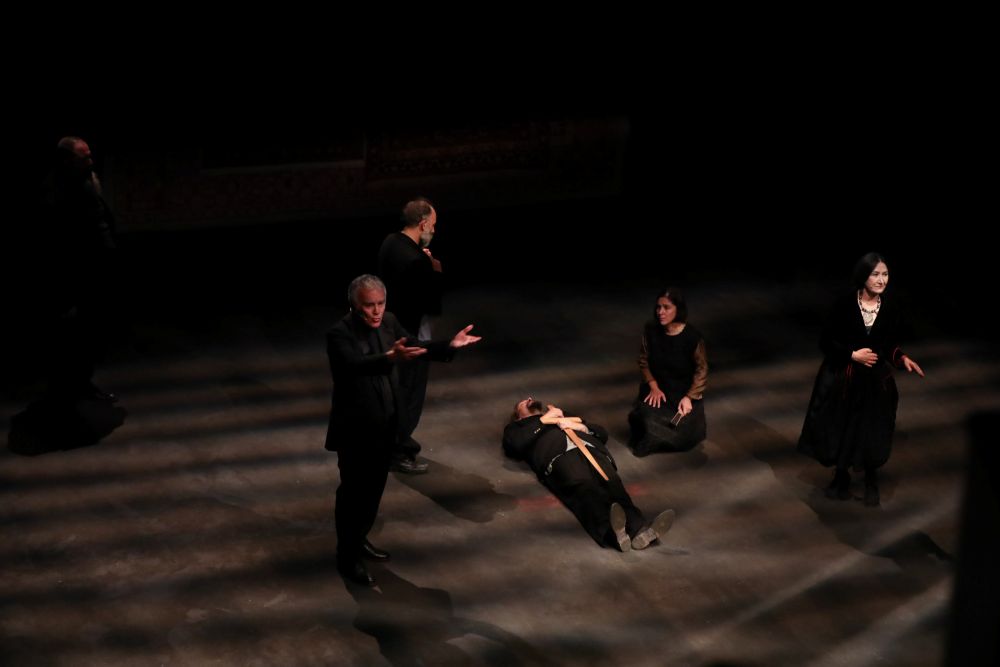 Their heroism in keeping energy levels so high when clad in black on one of the hottest nights of the year set a sweaty audience a good example in an epic that included all three parts (the third new, of course, this year) and ran from 8pm to well after midnight, with one short break for refreshment that kept us within the limits of the theatrical world (bread, wine and water from La Mancha, served within the theatre at the start of Part Three).
Their heroism in keeping energy levels so high when clad in black on one of the hottest nights of the year set a sweaty audience a good example in an epic that included all three parts (the third new, of course, this year) and ran from 8pm to well after midnight, with one short break for refreshment that kept us within the limits of the theatrical world (bread, wine and water from La Mancha, served within the theatre at the start of Part Three).
Part One – the journey through the riveting tableaux of the "enchanted castle" as well as the drama in the garden – lost nothing in the re-viewing (more words and pictures on that here). In fact it gained in current topicality when it came to the procession of convicts Don Quixote liberates and the burning of books by "reasonable people" who start with Don Quixote's library of knightly fantasies before running to the likes of Calvino, Simone Weil, Saul Bellow, the Gospels (favourite choices of the participating citizens). This time, after it, we walked past resident Stefano Ricci's second set of magical chalk drawings, the-figure-who-looks-like-Orson-Welles (Luca Fagioli detto Fagio) leading selected torch-bearers behind us. Ricci helps make this even more a total work of art; praise also to the incredible versatility of the rock band LEDA and the singer Serena Abrami.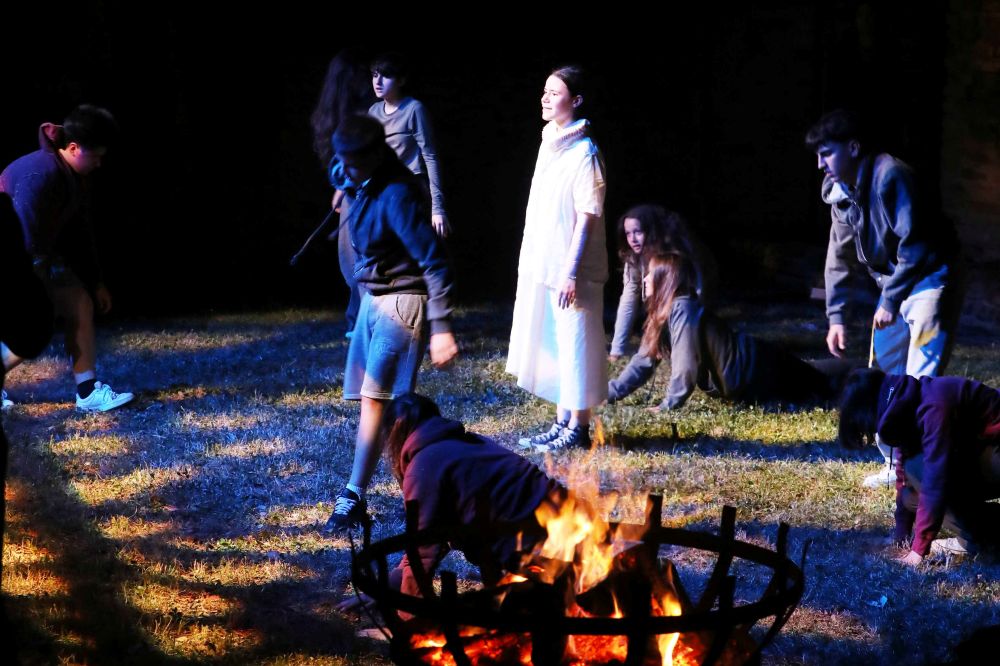 Part Two is shorter and, despite its haunting setting with lighting and fire brought powerfully into play, lighter of touch for the most part as our three protagonists move in and out of roles. Questions cosmic – the music of the spheres – and human invade the picture. Is the tragic abuse-history of the Girl with No Name accompanied by the choir of adolescents who alternate between standing and falling (pictured above by Silvia Lelli) a logical outcome? Probably not, but logic only fitfully emerges in this dream play, and the young actor (also not named) turns in a powerful performance.
Part Two is shorter and, despite its haunting setting with lighting and fire brought powerfully into play, lighter of touch for the most part as our three protagonists move in and out of roles. Questions cosmic – the music of the spheres – and human invade the picture. Is the tragic abuse-history of the Girl with No Name accompanied by the choir of adolescents who alternate between standing and falling (pictured above by Silvia Lelli) a logical outcome? Probably not, but logic only fitfully emerges in this dream play, and the young actor (also not named) turns in a powerful performance.
How often, then, are we actually moved? Rarely – the tone switches too often – but we're engaged at every point. Even, in Part Three, where Hermanita dances and verbalises obscurely with her teenage self before a beautiful background reproducing Rousseau's The Snake Charmer. 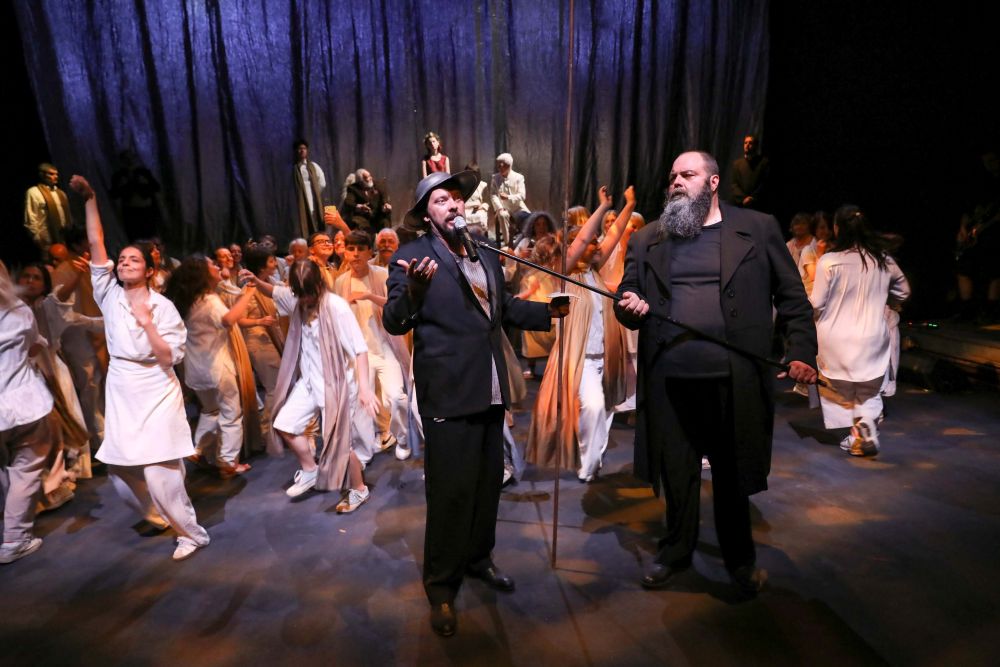 This new instalment otherwise clings closer to two stories in Cervantes' novel, both bringing the Citizens back into full action, both concerned with seeming and being: the wedding of Camaccio (pictured above by Silvia Lelli: Magnani's Don Quixote being recorded by Luca Fagioli detto Fagio as the-figure-that-looks-like-Orson-Welles) and Master Peter's puppet show. Argnani gives a virtuoso turn, rolling out Sancho's proverbs like a man possessed; Magnani, whose visionary and sad looks have provided much-needed emotion throughout, joins the four other main actors in giving a quietly distant take on Don Quixote's death.
This new instalment otherwise clings closer to two stories in Cervantes' novel, both bringing the Citizens back into full action, both concerned with seeming and being: the wedding of Camaccio (pictured above by Silvia Lelli: Magnani's Don Quixote being recorded by Luca Fagioli detto Fagio as the-figure-that-looks-like-Orson-Welles) and Master Peter's puppet show. Argnani gives a virtuoso turn, rolling out Sancho's proverbs like a man possessed; Magnani, whose visionary and sad looks have provided much-needed emotion throughout, joins the four other main actors in giving a quietly distant take on Don Quixote's death.
The final vision beyond mortality (pictured below by Silvia Lelli) is breathtakingly beautiful: the back apse of the church revealed, a boy with a torch moving forward next to the gold, winged horse which has long been a Teatro delle Albe fixture. Then the thanks to the participants from far and wide, the mingling: a fitting end to the greatest of communal experiences. 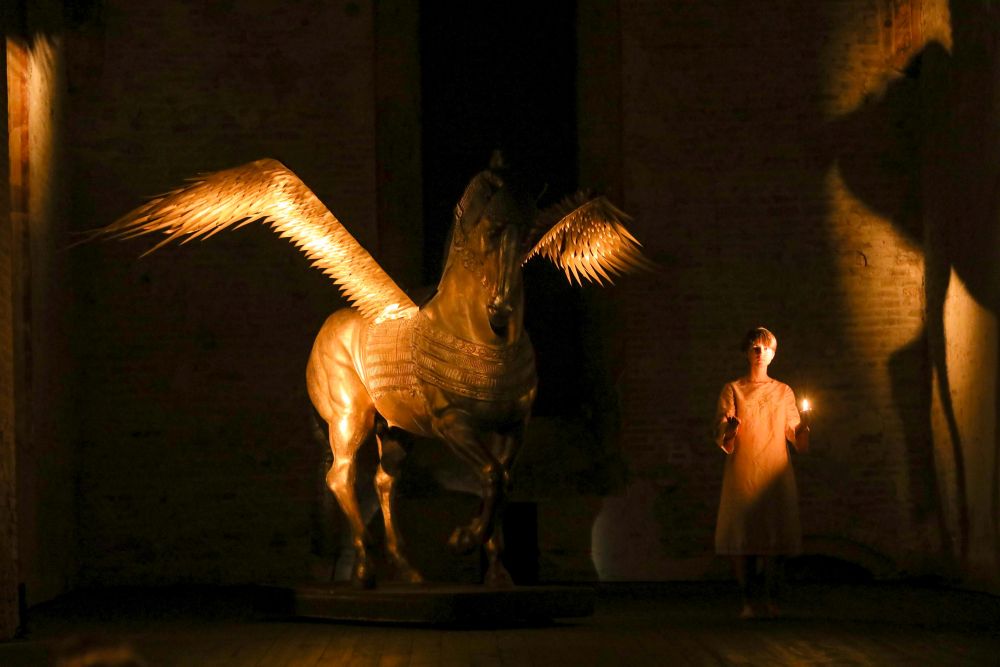 Intimacy and spontaneity are not an option surrounding the concerts held in the massive sports arena of the Palazzo Mauro de André; simply getting people in is a major operation. One notes, too, that Italians take the cult of personality very seriously; Riccardo Muti, 84 later this month, deserves all respect, as one of the greatest living conductors, but it's all "Maestro" this and "Maestro" that, even from the national critics. The proof, anyway, was in the performances of his second concert at the festival with his Orchestra Giovanile Luigi Cherubini, to give the Cherubini Youth Orchestra its full name.
Intimacy and spontaneity are not an option surrounding the concerts held in the massive sports arena of the Palazzo Mauro de André; simply getting people in is a major operation. One notes, too, that Italians take the cult of personality very seriously; Riccardo Muti, 84 later this month, deserves all respect, as one of the greatest living conductors, but it's all "Maestro" this and "Maestro" that, even from the national critics. The proof, anyway, was in the performances of his second concert at the festival with his Orchestra Giovanile Luigi Cherubini, to give the Cherubini Youth Orchestra its full name.
Here there's instant communication, instant friendliness, smiles and concentration all round. The perfect clarity of articulation within phrases that breathe, a thing of wonder throughout Muti's three Itaian opera performances in the Teatro Aligheri back in December 2023, was immediately apparent in the Overture (Sinfonia) to Verdi's I vespri Siciliani, the big melodies singing as they would from a human voice (full marks to cellos, subject to the conductor's special urging. Muti pictured below by FotoZani Casadio). 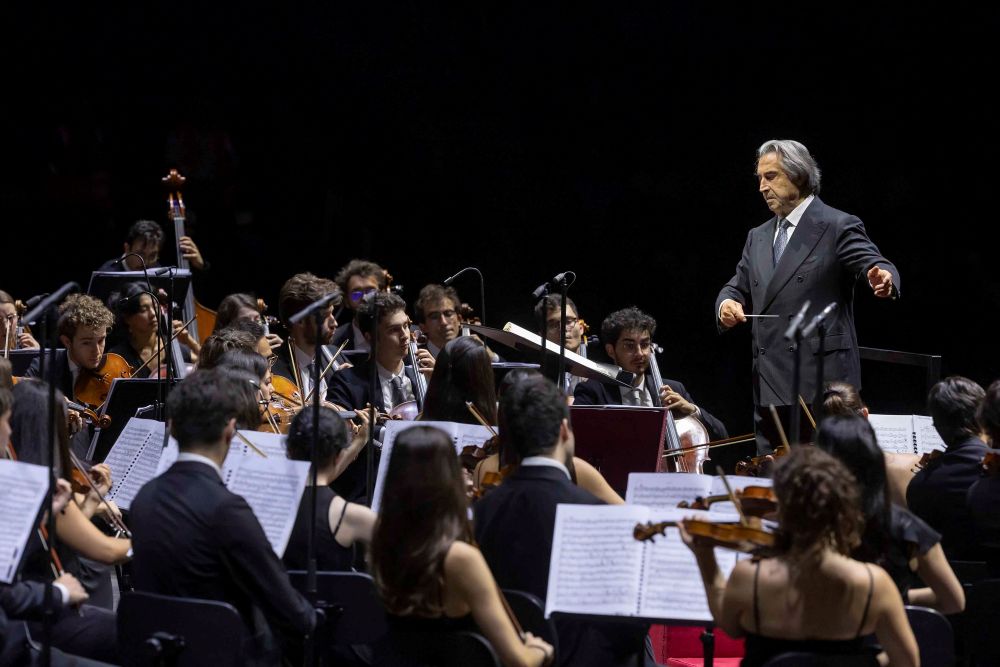 It felt as if the sound engineers necessary to such a space - Ravenna needs a proper concert hall – had turned up the sound on the violins at the start of Mendelssohn's Fourth, "Italian", Symphony. But the brilliance was essential. The nuancing at the quieter end of the scale was magical, and if the third movement sounded a bit too manicured for the natural flow implied, and heard on Muti's 1976 recording with the Philharmonia, the Saltarello finale duly fizzed in focus.
It felt as if the sound engineers necessary to such a space - Ravenna needs a proper concert hall – had turned up the sound on the violins at the start of Mendelssohn's Fourth, "Italian", Symphony. But the brilliance was essential. The nuancing at the quieter end of the scale was magical, and if the third movement sounded a bit too manicured for the natural flow implied, and heard on Muti's 1976 recording with the Philharmonia, the Saltarello finale duly fizzed in focus.
Even so, nothing quite prepared us for the rejuvenation of this Beethoven Five, easily the most vivacious performance of the work I've heard live. The second he stood on the podium, Muti plunged the young players into the opening gesture; audience reaction was very loudly heard in the pause that followed. No matter; we got the proper silence in the exposition repeat. My personal problem, blind spot, call it what you will, is that I've never warmed to the second movement or finale. Other than the ludicrously extended endings to both, Muti banished my doubts with an ideally free, forward-moving flow in what's essentially a set of variations, and the finale was both fast and just light enough. Dynamics were perfectly observed throughout, and the freshness of young players probably coming to this monument for the first time made a further difference. No wonder the Maestro left with vine leaves in his hair. 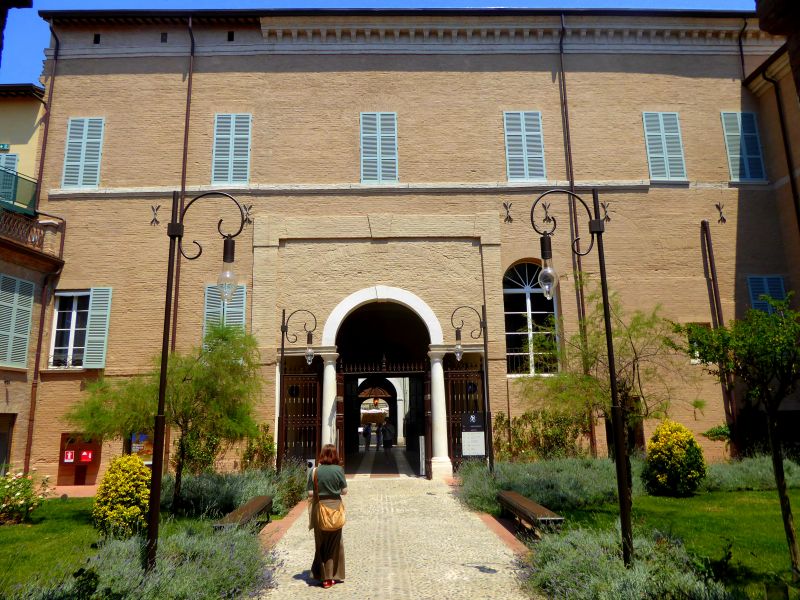
Both are beautifully done, with the Byron Museum mixing state-of-the-art technoloogy with a mixture of priceless items previously lodged in the city's Biblioteca Classense, many brought together by Teresa after Byron's death and including fragments of his skin gathered, if I interpret aright, after it peeled following sunburn from a three-hour swim. 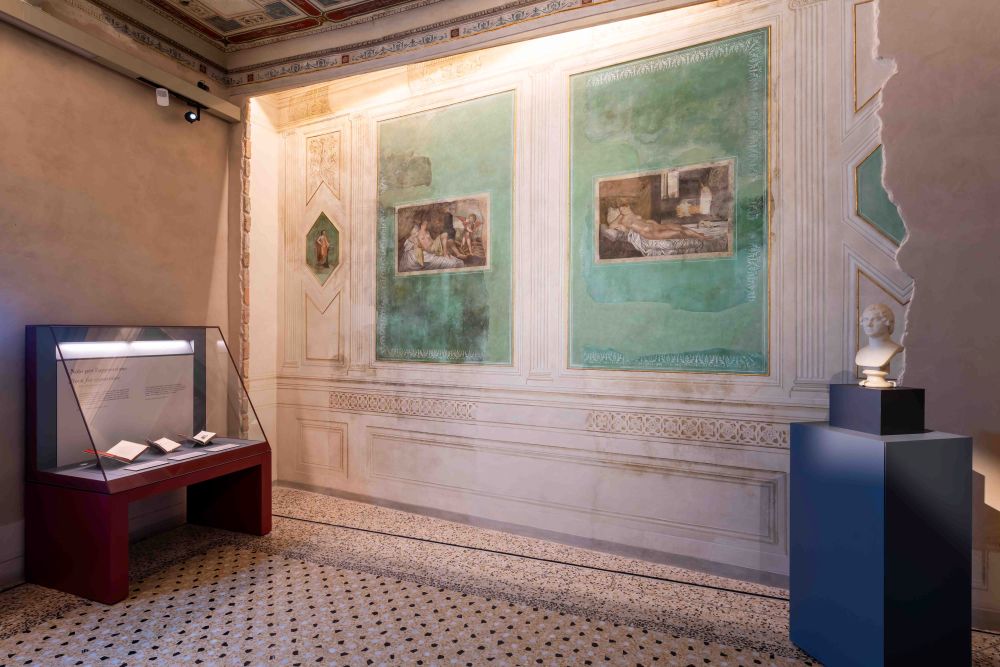 The Risorgimento Museum is worth seeing, too, as it has at its heart Byron's modest study, where removal of part of a wall reveals copies of Renaissance nudes he commissioned specially (they're dreadful). The connection is valid, too, as it was while with Teresa that Byron's new life as a political activist was born and led to his final days fighting for the cause of Greek independence.
The Risorgimento Museum is worth seeing, too, as it has at its heart Byron's modest study, where removal of part of a wall reveals copies of Renaissance nudes he commissioned specially (they're dreadful). The connection is valid, too, as it was while with Teresa that Byron's new life as a political activist was born and led to his final days fighting for the cause of Greek independence.
Here in Ravenna his prolific output included three Cantos of Don Juan, The Two Foscari - and The Prophecy of Dante, his most significant link with Ravenna's most celebrated literary inhabitant. The English have been encouraged to come here since Queen Camilla visited in April. Of course you must first see the eight UNESCO world heritage buildings with the world's most ravishing mosaics, such a bounty for what feels like a small town. At festival time? Well, the heat may be great too, but distances are small and shaded arcades line someofthe way. A city to return to again and again, one of my favourite places on the planet.
Explore topics
Share this article
The future of Arts Journalism
You can stop theartsdesk.com closing!
We urgently need financing to survive. Our fundraising drive has thus far raised £49,000 but we need to reach £100,000 or we will be forced to close. Please contribute here: https://gofund.me/c3f6033d
And if you can forward this information to anyone who might assist, we’d be grateful.

Subscribe to theartsdesk.com
Thank you for continuing to read our work on theartsdesk.com. For unlimited access to every article in its entirety, including our archive of more than 15,000 pieces, we're asking for £5 per month or £40 per year. We feel it's a very good deal, and hope you do too.
To take a subscription now simply click here.
And if you're looking for that extra gift for a friend or family member, why not treat them to a theartsdesk.com gift subscription?

Add comment